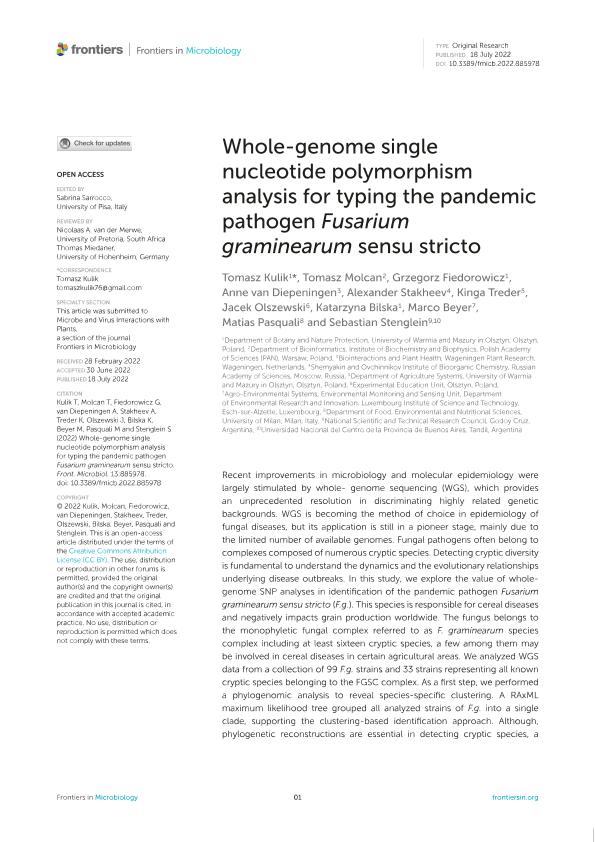Mostrar el registro sencillo del ítem
dc.contributor.author
Kulik, Tomasz
dc.contributor.author
Molcan, Tomasz
dc.contributor.author
Fiedorowicz, Grzegorz
dc.contributor.author
van Diepeningen, Anne
dc.contributor.author
Stakheev, Alexander
dc.contributor.author
Treder, Kinga
dc.contributor.author
Olszewski, Jacek
dc.contributor.author
Bilska, Katarzyna
dc.contributor.author
Beyer, Marco
dc.contributor.author
Pasquali, Matias
dc.contributor.author
Stenglein, Sebastian Alberto

dc.date.available
2023-07-10T19:36:41Z
dc.date.issued
2022-07
dc.identifier.citation
Kulik, Tomasz; Molcan, Tomasz; Fiedorowicz, Grzegorz; van Diepeningen, Anne; Stakheev, Alexander; et al.; Whole-genome SNP analysis for typing the pandemic pathogen Fusarium graminearum sensu stricto; Frontiers Media S.A.; Frontiers in Microbiology; 13; 7-2022; 1-9
dc.identifier.issn
1664-302X
dc.identifier.uri
http://hdl.handle.net/11336/203099
dc.description.abstract
Recent improvements in microbiology and molecular epidemiology were largely stimulated by whole- genome sequencing (WGS), which provides an unprecedented resolution in discriminating highly related genetic backgrounds. WGS is becoming the method of choice in epidemiology of fungal diseases, but its application is still in a pioneer stage, mainly due to the limited number of available genomes. Fungal pathogens often belong to complexes composed of numerous cryptic species. Detecting cryptic diversity is fundamental to understand the dynamics and the evolutionary relationships underlying disease outbreaks. In this study, we explore the value of whole-genome SNP analyses in identification of the pandemic pathogen Fusarium graminearum sensu stricto (F.g.). This species is responsible for cereal diseases and negatively impacts grain production worldwide. The fungus belongs to the monophyletic fungal complex referred to as F. graminearum species complex including at least sixteen cryptic species, a few among them may be involved in cereal diseases in certain agricultural areas. We analyzed WGS data from a collection of 99 F.g. strains and 33 strains representing all known cryptic species belonging to the FGSC complex. As a first step, we performed a phylogenomic analysis to reveal species-specific clustering. A RAxML maximum likelihood tree grouped all analyzed strains of F.g. into a single clade, supporting the clustering-based identification approach. Although, phylogenetic reconstructions are essential in detecting cryptic species, a phylogenomic tree does not fulfill the criteria for rapid and cost-effective approach for identification of fungi, due to the time-consuming nature of the analysis. As an alternative, analysis of WGS information by mapping sequence data from individual strains against reference genomes may provide useful markers for the rapid identification of fungi. We provide a robust framework for typing F.g. through the web-based PhaME workflow available at EDGE bioinformatics. The method was validated through multiple comparisons of assembly genomes to F.g. reference strain PH-1. We showed that the difference between intra- and interspecies variability was at least two times higher than intraspecific variation facilitating successful typing of F.g. This is the first study which employs WGS data for typing plant pathogenic fusaria.
dc.format
application/pdf
dc.language.iso
eng
dc.publisher
Frontiers Media S.A.
dc.rights
info:eu-repo/semantics/openAccess
dc.rights.uri
https://creativecommons.org/licenses/by/2.5/ar/
dc.subject
FUSARIUM GRAMINEARUM SENSU STRICTO
dc.subject
F. GRAMINEARUM COMPLEX
dc.subject
WHOLE-GENOME SEQUENCING
dc.subject
PLANT PATHOGEN
dc.subject
IDENTIFICATION
dc.subject.classification
Agronomía, reproducción y protección de plantas

dc.subject.classification
Agricultura, Silvicultura y Pesca

dc.subject.classification
CIENCIAS AGRÍCOLAS

dc.subject.classification
Micología

dc.subject.classification
Ciencias Biológicas

dc.subject.classification
CIENCIAS NATURALES Y EXACTAS

dc.title
Whole-genome SNP analysis for typing the pandemic pathogen Fusarium graminearum sensu stricto
dc.type
info:eu-repo/semantics/article
dc.type
info:ar-repo/semantics/artículo
dc.type
info:eu-repo/semantics/publishedVersion
dc.date.updated
2023-07-10T10:41:08Z
dc.journal.volume
13
dc.journal.pagination
1-9
dc.journal.pais
Suiza

dc.description.fil
Fil: Kulik, Tomasz. Department Of Botany And Nature Protection, University; Polonia
dc.description.fil
Fil: Molcan, Tomasz. Department Of Bioinformatics, Institute Of Biochemistry; Polonia
dc.description.fil
Fil: Fiedorowicz, Grzegorz. Department Of Botany And Nature Protection, University; Polonia
dc.description.fil
Fil: van Diepeningen, Anne. Biointeractions & Plant Health, Wageningen Plant Res; Países Bajos
dc.description.fil
Fil: Stakheev, Alexander. Shemyakin And Ovchinnikov Institute Of Bioorganic Chem; Rusia
dc.description.fil
Fil: Treder, Kinga. Department Of Agriculture Systems, University Of Warmia; Polonia
dc.description.fil
Fil: Olszewski, Jacek. Experimental Education Unit; Polonia
dc.description.fil
Fil: Bilska, Katarzyna. Department Of Botany And Nature Protection, University; Polonia
dc.description.fil
Fil: Beyer, Marco. Agro-environmental Systems, Luxembourg Institute; Luxemburgo
dc.description.fil
Fil: Pasquali, Matias. Department Of Food, University Of Milan; Italia
dc.description.fil
Fil: Stenglein, Sebastian Alberto. Consejo Nacional de Investigaciones Científicas y Técnicas. Centro Cientifico Tecnolológico Mar del Plata. Instituto de Investigaciones en Biodiversidad y Biotecnología. Laboratorio de Biología Funcional y Biotecnología; Argentina
dc.journal.title
Frontiers in Microbiology
dc.relation.alternativeid
info:eu-repo/semantics/altIdentifier/doi/http://dx.doi.org/10.3389/fmicb.2022.885978
dc.relation.alternativeid
info:eu-repo/semantics/altIdentifier/url/https://www.frontiersin.org/articles/10.3389/fmicb.2022.885978/full
Archivos asociados
